Ecological Challenges
Help us to restore, preserve and protect the rich marine habitat of the Gulf of Mexico
What is Red Tide?
Red tides are caused by the explosive growth and accumulation of certain microscopic algae, predominantly dinoflagellates, in coastal waters. Some species of dinoflagellates produce toxins that are among the most potent known to man. These harmful algal blooms, or HABs for short, pose a serious and recurrent threat to human health, wildlife, marine ecosystems, fisheries, coastal aesthetics, and our economy. The most troublesome species in the Gulf of Mexico is Karenia brevis. Like other dinoflagellates these tiny, single-celled organisms photosynthesize using chlorophyll like a plant yet are motile and have two flagella that propel the organism through the water column.
Their dominant mode of reproduction is asexual cell division-one cell divides into two cells, those two split into four, and so on. Given the right conditions, the population size will rapidly rise. For a population to expand quickly and sustain itself over time requires the confluence of a number of factors that, to date, are not fully understood.
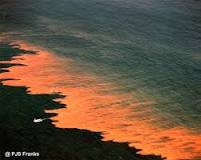
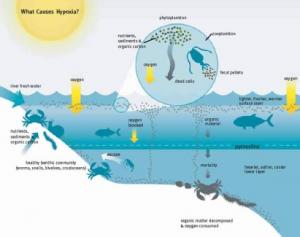
What is the Dead Zone?
The Gulf of Mexico Dead Zone is a large region of water that is very low in oxygen, a condition known as "hypoxia" and therefore can't support life. Dead Zones like this occur along many of the world's coastlines.
Over the past decade, the Dead Zone has grown to an area over 7,000 sq miles, an area larger than the state of Pennsylvania, or the surface area of all the lakes of Minnesota combined. Above the water, the Gulf of Mexico Dead Zone doesn't look any different from the surrounding waters. But along the bottom, there's practically no oxygen -- so fish don't swim in it, and bottom dwelling creatures die off.
What is Bottom Trawling?
Bottom trawling involves dragging a huge net the size of a soccer field and fitted with heavy metal plates across the ocean floor. It is going on now in our high seas, without limit or law. A handful of countries that allow bottom trawling are wreaking havoc in our oceans that will take centuries for the oceans to recover. Each year they destroy all reef and accompanying marine life in an area twice the size of the USA, systematically wiping out all deep sea life just to catch a few fish. Over 1100 scientists from 69 countries have stated that bottom trawling is a MAJOR environmental threat that must be stopped immediately. UN negotiators are trying to craft a proposal to submit to the General Assembly for a vote in early December.
We must all write to our government leaders demanding to outlaw this inefficent and environmentally destructive method of fishing that's causing global devastation daily to the world's oceans by a handful of irresponsible countries and fishing vessels. Perhaps then UN representatives will ratify the proposal to ban bottom trawling when it finally makes it to the General Assembly for a vote.

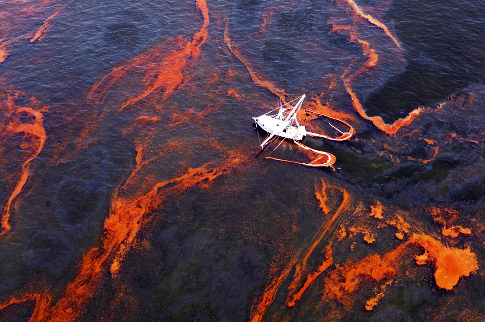
Gulf Oil Disaster
The Gulf of Mexico Dead Zone is a large region of water that is very low in oxygen, a condition known as "hypoxia" and therefore can't support life. Dead Zones like this occur along many of the world's coastlines.
Over the past decade, the Dead Zone has grown to an area over 7,000 sq miles, an area larger than the state of Pennsylvania, or the surface area of all the lakes of Minnesota combined. Above the water, the Gulf of Mexico Dead Zone doesn't look any different from the surrounding waters. But along the bottom, there's practically no oxygen -- so fish don't swim in it, and bottom dwelling creatures die off.
Dolphin Hunting
Bottom trawling involves dragging a huge net the size of a soccer field and fitted with heavy metal plates across the ocean floor. It is going on now in our high seas, without limit or law. A handful of countries that allow bottom trawling are wreaking havoc in our oceans that will take centuries for the oceans to recover. Each year they destroy all reef and accompanying marine life in an area twice the size of the USA, systematically wiping out all deep sea life just to catch a few fish. Over 1100 scientists from 69 countries have stated that bottom trawling is a MAJOR environmental threat that must be stopped immediately. UN negotiators are trying to craft a proposal to submit to the General Assembly for a vote in early December.
We must all write to our government leaders demanding to outlaw this inefficent and environmentally destructive method of fishing that's causing global devastation daily to the world's oceans by a handful of irresponsible countries and fishing vessels. Perhaps then UN representatives will ratify the proposal to ban bottom trawling when it finally makes it to the General Assembly for a vote.
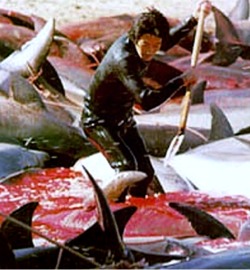
Seasteading
Informing the international community of the opportunity to create floating city - states on abandoned oil drilling platforms in the Gulf of Mexico.
What is Seasteading?
Seasteading is the concept of creating permanent dwellings at sea, called seasteads, outside the territory claimed by the government of any standing nation. Some proposed seasteads have been modified cruising vessels.
Larry Bestor, president of Gulf Coast Preservation Society, first proposed the conversion of abandoned offshore oil platforms into independently owned, sustainable developments and floating wildlife sanctuaries in a 2007 paper he wrote on the subject of dealing with environmental problems facing the Gulf of Mexico.
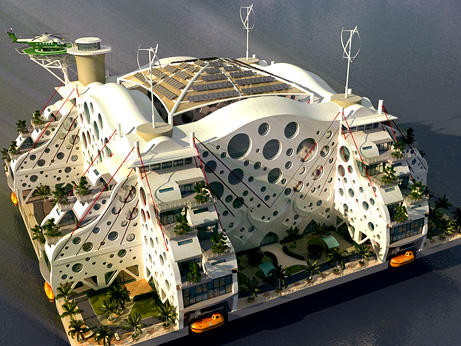
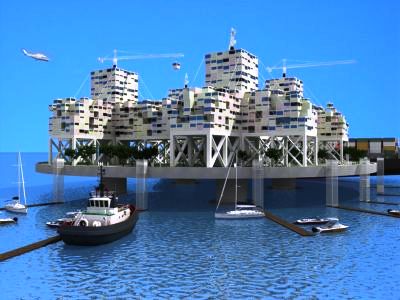
Gulf of Mexico: Unique opportunity
In 2008 Patri Friedman, grandson of Nobel Prize laureate Milton Friedman, perhaps inspired by Mr. Bestor's aforementioned paper, proposed the notion of creating independent city-states from oil platforms that exist beyond the 20 mile limit claimed by the US. Since then, a variety of offshore business ventures have been suggested, such as hospitals, casinos, hotels, and luxury resorts.
There are currently over 25,000 abandoned oil platforms in the Gulf of Mexico, some of which could be used and converted to clean, sustainable commercial businesses. We hope you will contact us for more information about how you can begin to participate in this exciting new oceaneering opportunity.